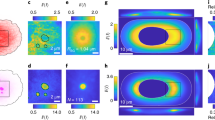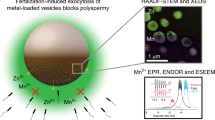Abstract
Cytoplasmic polarity giving rise at mitosis to daughter cells with distinct but complementary morphogenetic functions has been proposed by Jaffe and co-workers to have transcellular ion currents as one of its essential physiological steps1. The clearest evidence is from fucoid eggs in which such currents have been shown to parallel the prospective axis of germination2,3. The currents are caused by stabilized accumulations of cation pumps on one side of the cell, and of permeability channels on the opposite side4; they are strong enough to suggest that the accompanying gradient in electrical potential could have an electrophoretic effect on the distribution of cytoplasmic constituents, including those that serve as morphogenetic determinants. Although ion currents correlated with axes of morphogenesis have thus been clearly established, their effects on intracellular localizations and morphogenetic activity have remained speculative5. We report here evidence that an endogenously generated gradient in electrical potential in the oocyte–nurse cell syncytium of Hyalophora cecropia can, in fact, influence the distribution of soluble proteins in a cytoplasmic continuum.
This is a preview of subscription content, access via your institution
Access options
Subscribe to this journal
Receive 51 print issues and online access
$199.00 per year
only $3.90 per issue
Buy this article
- Purchase on Springer Link
- Instant access to full article PDF
Prices may be subject to local taxes which are calculated during checkout
Similar content being viewed by others
References
Jaffe, L. F. Membrane Transduction Mechanisms (eds Cone, R. A. & Dowling, J. E.) (Raven, New York, 1979).
Jaffe, L. F. Proc. natn. Acad. Sci. U.S.A. 56, 1102–1109 (1966).
Nuccitelli, R. Devl Biol. 62, 13–33 (1978).
Robinson, K. R. & Jaffe, L. F. Science 187, 70‐72 (1975).
Quatrano, R. S., Brawley, S. H. & Hogsett, W. E. in Determinants of Spatial Organization (eds Subtelny, S. & Konigsberg, I. R.) (Academic, New York, 1979).
Mandelbaum, I. J. Morph. (in the press).
Woodruff, R. I. & Telfer, W. H. J. Cell Biol. 58, 172–188 (1973).
Pollack, S. & Telfer, W. H. J. exp. Zool. 170, 1–24 (1969).
Hughes, M. & Berry, S. Devl Biol. 23, 651–664 (1970).
Grundlach, H. G., Stein, W. H. & Moore, S. J. biol. Chem. 234, 1754–1761 (1959).
Jaffe, L. F. & Nuccitelli, R. A. Rev. Biophys. Bioengng 6, 445–476 (1977).
Flemming, W. Arch. microsk. Anat. Entw. Mech. 37, 685–751 (1891).
Byers, B. & Abramson, D. H. Protoplasma 66, 413–435 (1968).
Ashman, R. F., Kanno, Y. & Loewenstein, W. R. Science 145, 604–605 (1964).
Nairn, R. C. Fluorescent Protein Tracing (Churchill Livingston, New York, 1976).
Woodruff, R. I. Devl Biol. 69, 281–295 (1979).
Author information
Authors and Affiliations
Rights and permissions
About this article
Cite this article
Woodruff, R., Telfer, W. Electrophoresis of proteins in intercellular bridges. Nature 286, 84–86 (1980). https://doi.org/10.1038/286084a0
Received:
Accepted:
Issue Date:
DOI: https://doi.org/10.1038/286084a0
This article is cited by
-
Bioelectric memory: modeling resting potential bistability in amphibian embryos and mammalian cells
Theoretical Biology and Medical Modelling (2015)
-
The Work Surfaces of Morphogenesis: The Role of the Morphogenetic Field
Biological Theory (2014)
-
Endogenous voltage gradients as mediators of cell-cell communication: strategies for investigating bioelectrical signals during pattern formation
Cell and Tissue Research (2013)
-
Role of Membrane Potential in the Regulation of Cell Proliferation and Differentiation
Stem Cell Reviews and Reports (2009)
-
In vitro culture ofDrosophila ovarian follicles: The influence of different media on development, RNA synthesis, protein synthesis and potassium uptake
Roux's Archives of Developmental Biology (1991)
Comments
By submitting a comment you agree to abide by our Terms and Community Guidelines. If you find something abusive or that does not comply with our terms or guidelines please flag it as inappropriate.



